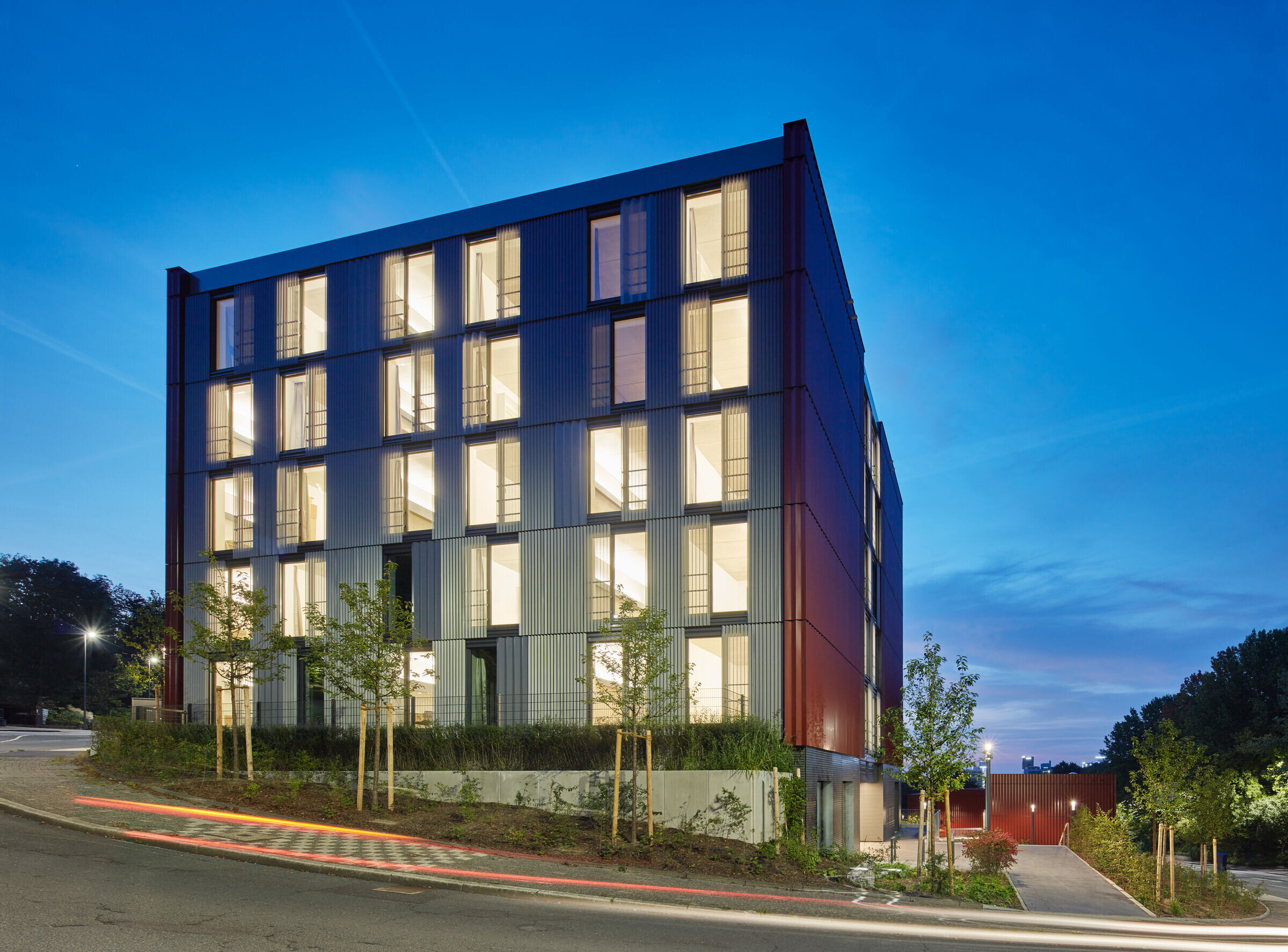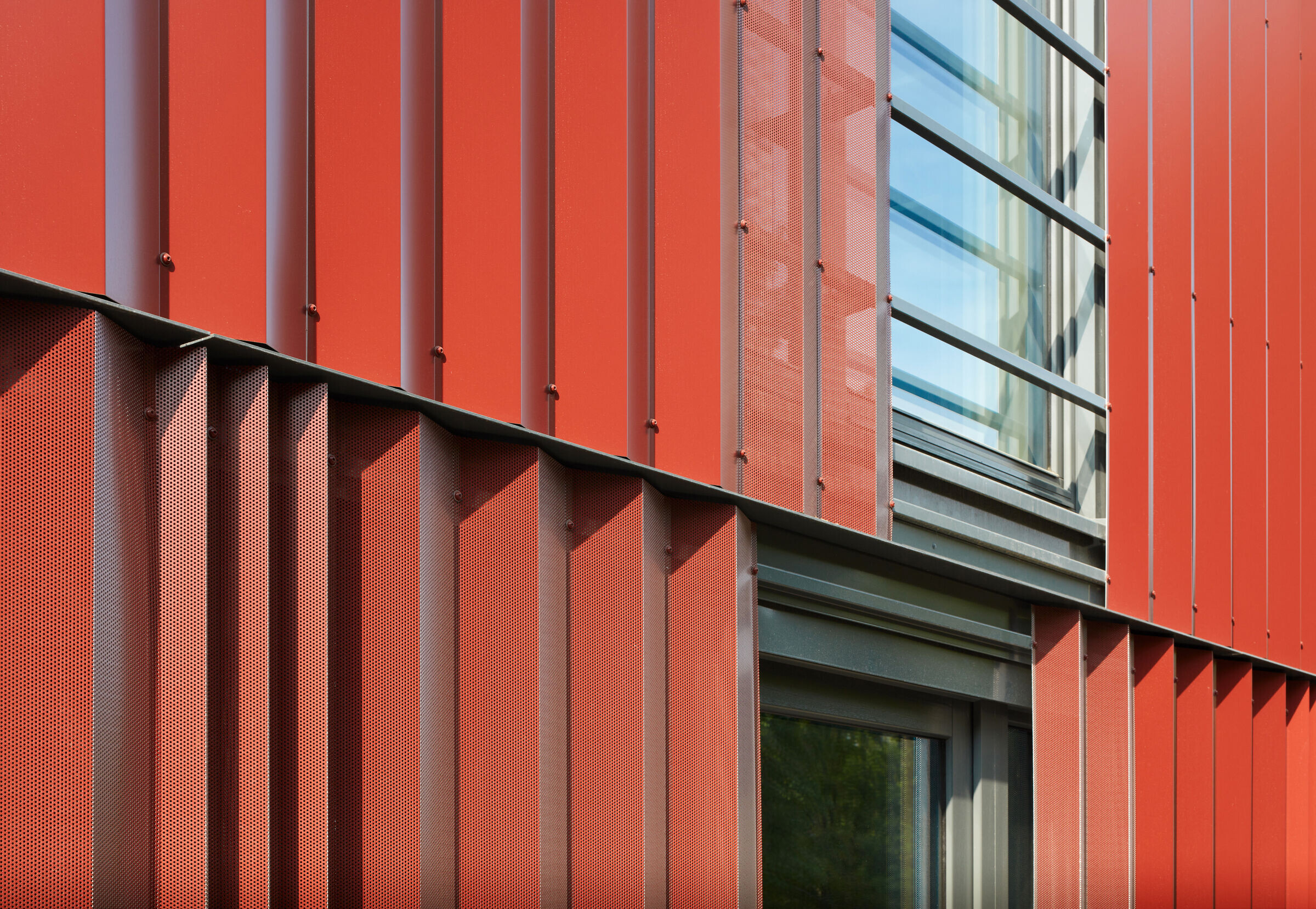Design concept
In the immediate vicinity of the Bergische Universität Wuppertal, a remaining plot of land was used to provide 132 student housing units. The site was considered undevelopable due to its very narrow layout and extreme slope (18m difference in height). The design transforms the specific features into an advantage: the slope is used to offset the height of the houses and to minimise the built-up areas. The narrowness of the site is compensated for by means of designed boundary transgression. The greenery of the adjacent allotment garden settlement flows between the houses into the outdoor facilities of the student accommodation. The existing infrastructure of the university with public transport, car parks, catering, computer centre and connection to district heating is used. The profiled and partially perforated façade elements are laid over the basic structure like a curtain that is opened in different ways. This allows a balance between openness and discretion and creates a differentiated design of the building type.

Innovation
With the Variowohnen funding programme, the BMUB aims to create affordable housing for students, trainees and senior citizens as part of the Zukunft Bau research initiative. The amount of funding is based on the innovation potential. This project meets many of the funding criteria and was therefore classified as an outstanding model project by the funding body. The buildings realised in publicly funded housing achieve the DBNB Gold Standard. 70% of the housing units are handicapped accessible, the rest are adjustable. The living space of 30m² per person is 40% below the national average. By means of e-mobility, car sharing and public transport, the parking space requirement was reduced to 20%. The levels of use can be reorganised without interfering with the supporting structure. Grey energy was significantly reduced by means of wooden panel constructions and lightweight construction methods; the savings in the façade constructions, for example, amount to over 200 tonnes of CO2. In order to document the innovative approaches from the Variowohnen funding programme, the entire planning and construction phase was scientifically supported and evaluated.

Certification
These buildings, realised as part of publicly subsidised housing, achieve the DBNB Gold Standard. The design in passive house quality exceeds the current requirements of the Energy Saving Regulation (EnEV). Near enough pollutant-free interior: Here, the highest standards according to DGNB were once again significantly undercut.
Transformation potential with regard to ecological sustainability
The special importance of the reusability of buildings arises from the realisation of the high environmental impacts from the manufacturing and recycling phases. Even with the approach of a building structure designed on the basis of the circular economy concept (cradle to cradle), new resources are generally used in each change phase of the cycle. The most environmentally advantageous scenario is therefore the direct re-use of buildings or as large a part of the building structure as possible. This applies in particular where there is a lack of clarity about subsequent recycling possibilities.
In the area of after-use scenarios, different use variants were presented and examined for their advantages and disadvantages. At the time of planning, the Variowohnen programme specified student housing as the initial use and developed the floor plans accordingly. Due to the increasing number of students and a higher demand for affordable housing, a tighter housing market for students is to be expected in urban conurbations in the coming years. It was already taken into account in the planning phase that various living concepts can be implemented in the later stages of use of the building. The axial dimension is designed in such a way that a divergent use, such as office use, would also be possible as a conversion scenario.


Economy
The buildings are designed as a modular system. Various prefabricated elements are organised in such a way that a variable design of the individual buildings as well as flexible subsequent use, are possible. In detail, the following systems were chosen:
- Shell made of prefabricated reinforced concrete elements and hollow prestressed concrete planks.
- Façade made of wooden panel elements with integrated, decentralised ventilation systems with heat recovery
- Sanitary cells made of self-supporting sandwich elements of sheet steel.
Thanks to the prefabrication of the timber panel elements in the factory, wood as a building material contributes to a reduction in construction time and ensures a significantly improved CO2 balance. Thanks to the hybrid construction method, thermal bridges can be minimised and potential energy losses minimised, which has a positive effect on operating costs.

Social
The future users were involved in the processes at an early stage; the buildings were planned not only for the owner, the Hochschul-Sozialwerk Wuppertal, but for and with the users. An essential success factor for such small spatial conditions is to create the greatest possible acceptance, which can be achieved above all through high-quality design, but also through high interior variability and various possible uses. The high-quality partial furnishing in terms of design and quality offers space for personal development and a personal touch. It uses a colour scheme that creates identity but is not obtrusive.
Reducing the living space per person to a maximum of 30m² including communal areas presupposes that, in addition to the guaranteed individual spaces, variably usable communal areas are offered. In this building project, these are provided as decentralised zones in the residential groups, at a central location for larger events and by incorporating the open spaces. In the basement of House 168, for example, there are spacious communal areas and a study room.
In the ecologically designed open spaces, there are both communal and individually usable areas. Here, a differentiated offer is provided in the form of recreational areas and kitchen gardens for self-sufficiency (urban gardening). The character of the neighbouring allotment garden settlement is continued in the plant terraces provided.
Client
Hochschul-Sozialwerk Wuppertal AöR
Architect
ACMS Architekten GmbH, Wuppertal
Structural Engineer
T|S|B Ingenieurgesellschaft mbH, Darmstadt
Building Services Planners
Wortmann & Wember GmbH, Bochum
Landscape Architect
FSWLA Landschaftsarchitektur, Düsseldorf
Colour Concept
Farb-Bau, Prof. Friedrich Schmuck, Dinslaken
Photographer
Sigurd Steinprinz, Düsseldorf

































